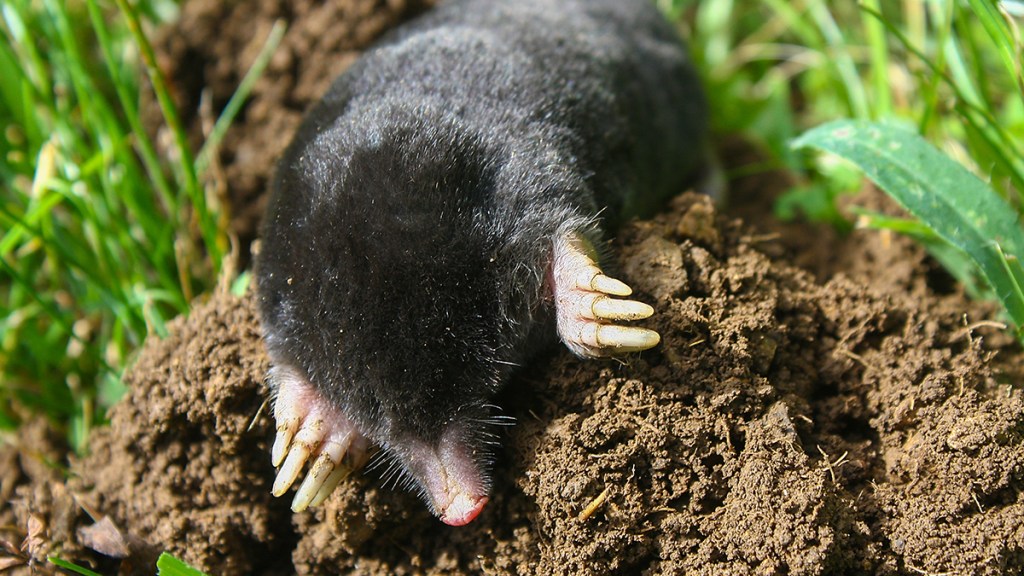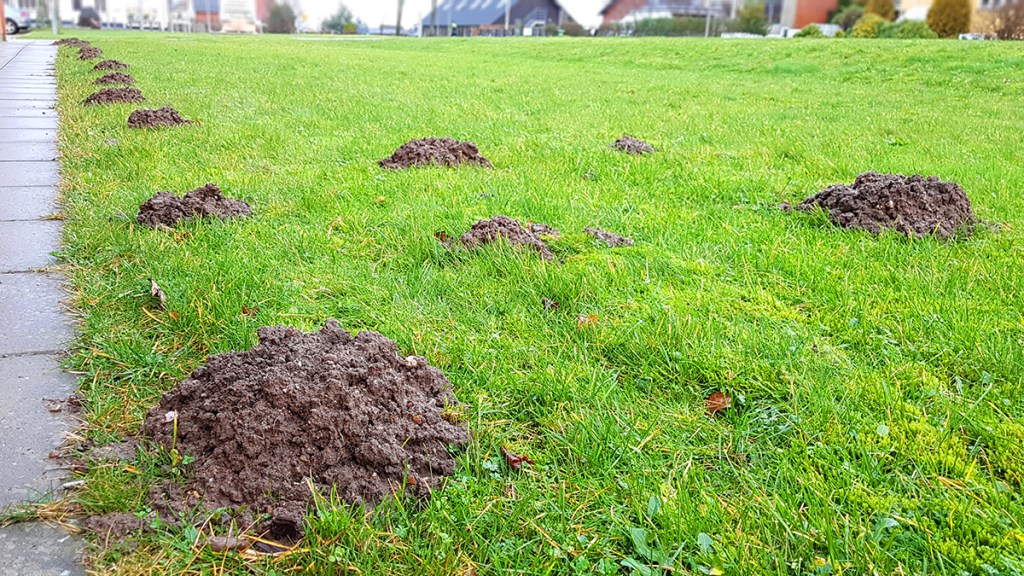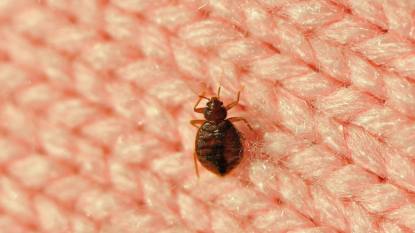The Genius Castor Oil Spray That Keeps Moles From Ruining Your Lawn and Garden
Plus 5 more landscaper-approved ways to send the critters packing

Notice those fat, furry creatures popping out of holes in your grass and snacking on your lawn? They may appear cute and harmless, but if you’re worried about them, you certainly are not making a mountain out of a molehill: they can actually do some serious damage to your lawn and possibly even your home. Rather than play a live action version of “whack a mole,” each time you see them, we asked the professionals for the best ways to deter moles without harming them or your property.
What exactly are moles?

You know what they say: Know your enemy. Small, furry gray mammals, moles are, surprisingly, not rodents but known as talpidae, an animal family that also includes shrews. They feature tiny eyes and no (external) ears; a long, thin snout; and big ol’ front paws n’ claws they use to dig tunnels underground. They can be found in pretty much all parts of North America (Europe and Asia, too). Their main food sources are grubs and earthworms — which is why they can be attracted to burrow in the nutrient-rich soil around your lawn.
Why do I want to deter moles?

Moles aren’t all bad — they help aerate soil and will eliminate grub infestations faster than any pesticide can. “But unfortunately, the tunnels they dig can often cause more harm than good — and in some extreme cases have even harmed the foundations of homes and other structures,” explains landscaper Tom Monson of Monson Lawn and Landscape. Not to mention that the molehills they leave behind can make a mess of your lawn.
Small, but mighty, they can dig up to 18 feet per hour and can also damage in-ground sprinkler systems and plant roots, attract weeds and provide an underground highway system for mice and rats to join the small-yet-destructive mammal party in your yard.
What are the signs of a mole problem?
Think you might have moles? Look out for these signs in your yard.
- Raised ridges indicating their tunnels spanning across your yard
- Areas of brown, yellow or dead grass
- Small holes surrounded by piles of soil that look like little volcanos
- Soil that feels loose or unstable
How to deter moles safely
The great news is, there’s no shortage of safe, natural methods to deter moles — and chase them off if they do decide to venture into your yard.
Just try one or more of the easy strategies below.
Spray castor oil around molehills
Castor oil comes from the plant by the same name and features a somewhat strong earthy/funky odor. Moles, which are mostly blind due to living underground, have an extremely strong sense of smell to make up for it — and one thing their astute noses don’t like? The smell of castor oil.
In a spray bottle, combine three parts castor oil, three parts water and one part dish soap, then spritz any visible molehills or raised trails. Repeat for two weeks or until the moles move on.
“Castor oil is so effective, it’s also found in many store-bought mole repellents,” Monson adds. Two options: Molemax Mole & Vole Repellent, (Buy from Amazon, $19.52) or Victor Dual Action Mole & Gopher Repellent (Buy from Lowe’s, $10.98).
Sprinkle some (used) kitty litter over mole trails
You’ll also need the help of a kitty or two, since it’s used litter that does the trick, explains gardener Jill Sandy, founder of Constant Delights. “To deter moles, sprinkle the used litter over the mole trails about every three feet or so, and around their entry and exit areas. The smell will make them think predators are marking territory nearby and they’ll head off for a safer location.”
Place these plants around your yard

Yes, moles have opinions about your gardening choices, and certain flowers are offensive to them. “Daffodils and marigolds are two excellent flowers that deter moles,” assures lawn care specialist Nikki Thomas, co-founder of Backyardville. “Daffodil bulbs are actually toxic to moles, so they’ll give those a wide berth, and they deeply dislike the strong scent marigolds give off. Just plant them in a border around your garden beds or on the edge of your property to ward off the critters.”
Other mole-offending options include alliums, fritillaries, garlic, shallots, chives, basil, sage, rosemary and mint. You can plant castor bean plants, too, of course, but be cautious if you have pets or young children, since ingesting the raw plant can make them sick.
Water your lawn a bit less
Moles prefer moist soil because it’s easier for them to dig through and attracts the bugs they enjoy feasting on. “First and foremost, if you’re having any drainage issues on your lawn, addressing that will not only help deter moles but prevent mold and mildew issues, as well,” says Thomas. “Otherwise, if you notice signs that moles are on your property, simply stop watering for a few weeks. An ‘artificial drought’ can sometimes be enough to send them away.”
Eliminate their food source
“Moles only come knocking if your yard provides them with an abundant food supply — and that comes mainly in the form of grubs and earthworms,” says Robert Martinez, landscaper and author at Yardenz. If you prefer to leave your soil-improving worm population alone, you can still cut moles’ menu in half by removing grubs, which are harmful to your plants. The best way to do just that? Sprinkle milky spore on your grass. It’s a natural fungus that will permanently settle into the soil. It’s totally harmless to you, animals and even worms — but spells the end for grubs (bonus: it also kills invasive Japanese beetles). One to try: Gabriel Organics Milky Spore Organic Grub Control, (Buy from Walmart, $43).
Looking to lower your worm population, too? The best way to do that is to bring in more birds. Set up feeders and/or bird baths around your property. Feathered friends will come for the seeds and stay for the early-morning worm feast.
Raise the volume with these repellants
While moles may not have external ears, their sense of hearing is still finely tuned, as is their sensitivity to vibrations. Which means they prefer a relatively quiet environment. That’s where ultrasonic repellents come in. They look like plastic railroad spikes. Simply stick them in the soil and leave the top — which has a small solar panel on it — exposed above ground where it can get some sun. The spikes send out electronic pulses through the ground that will deter moles. One option: Solar Powered 6-Pack Mole Repellent Ultrasonic for Vole, Snakes, Gopher (Buy from Amazon, $32.99).
This video shows how easy it is to set it up:
How can I stop moles for good?
While this method may be more labor intensive, it also offers a virtually permanent solution to any mole problem: Dig a trench 2-feet deep and about 6 inches wide around any area you want to keep the moles away from. Line the trench with chicken wire or wire mesh, then fill in with rocks. Voila! An impenetrable “mole moat” even the most determined varmint won’t be able to dig through.
Lindsay Bosslett is currently associate vice president and managing editor for Health Monitor Network, a patient-education print and digital publishing company. In her role there, she oversees a staff of editors and freelance writers, as well as the production of guides and magazines designed to help both patients and healthcare providers in the ever-changing point-of-care space. As a regular writer for both Woman’s World’s Organized column and First for Women’s Life Smarts page, she delivers practical, creative tips to help women make their lives easier. In her free time, Lindsay enjoys reading, hiking, gardening and attending taco festivals. She lives with her husband, two dogs and lots of bears in a little house on a hill in West Milford, N.J.













